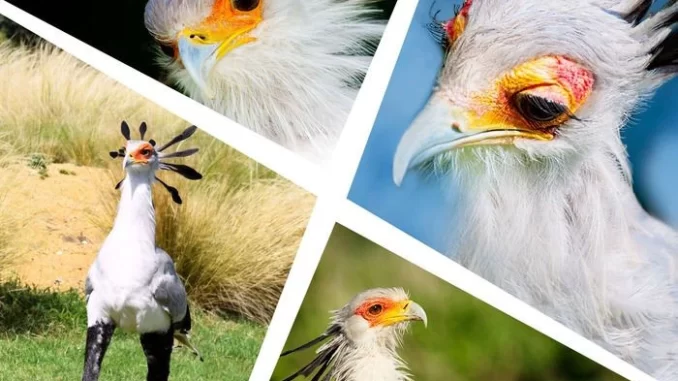
The Secretary Bird with scientific name Sagittarius serpentarius, is a large raptor related to hawks as well as eagles. This large, terrestrial bird of prey is indigenous to the open grasslands in sub-saharan Africa. The Secretary Bird is famous for being the prominent emblem of Sudan and South Africa and appears on both nations coat of arms. These birds, sometimes known as The Sagittarius, are so called because of their quill-like crests on the backs of their heads that resemble 18th century clerks with pens tucked into their wigs.
The Secretary bird has an appearance more like a stork or crane than a bird of prey. These tall birds can measure approximately 1.4 metres in height, weigh about 3.3 kilograms and have a wingspan of over 2 metres according to National Geographic. The Secretary bird has a small head with small eyes and a hooked beak. Its plumage is a light blue, almost grey and it has a red coloured face. Flight feathers are black and they have black feathers on the thighs and on the back of their heads as well. Their legs are long and powerful and are used for striking and pursuing prey. Sagittarius birds have two central elongated feathers on their tail which extend beyond their feet when in flight. They have tough scales on their legs to help protect their legs from snake bites. Secretary birds do not have grasping toes like other birds of prey, instead their toes are thick and blunt with short curved talons on the ends. Both male and female are similar in appearance.
While the Secretary bird has a lot in common with other birds of prey, like strong legs and an impressive wingspan, they have something else to show off. This is a bird with eyelashes. In adults, the naked facial skin is a beautiful color of orange and red, featuring big, wondrous eyes and really long lashes.
These majestic birds prefer open grasslands, steppe and tree-dotted savannas. They live in areas where grass is fairly short so they can see prey more easier as they walk along. They build large nests in Acacia trees or thorn trees made from long, flat twigs and grass and can measure 2.4 meters wide and 30 centimetres deep – thank you National Geographic. Nests grow larger year by year. Nests are returned to just before dark to roost in overnight after a days hunting on the ground. Secretary birds avoid forests and dense shrubberies as they might restrict their movement.
The sublime Secretary birds are carnivorous raptors who feed up on a variety of prey. They are famous for their ability to kill snakes on the African grasslands. This bird may travel over 30 kilometres a day in search of snakes, insects and other animals. They feed up on snakes such as Adders and even Cobras but will also consume lizards, amphibians, rodents and birds eggs. Small animals are eaten whole, however, larger prey is stamped to death before being consumed. Dangerous prey, such as snakes, are first stamped on to stun them and then pecked behind their neck to kill them. The secretary bird also stamps on the ground with its large stout-toed feet to flush prey out of hiding.
Sagittarius birds are territorial and occupy areas of around 40 – 50 square kilometres as reported by BBC. Although the secretary bird is a good flyer, it spends most of its time on the ground. It flies well but needs a long take-off run prior to leaving the ground. These incredible birds mate for life and although out of breeding season they can be solitary, the other half of a pair is usually not far away. Sagittarius birds are silent nearly all of the time. The only sound they make is a croaking sound when displaying for a mate.
Courtship includes a mutual display of chasing each other with wings spread up and backwards much like they perform when chasing ground prey. Mating takes place either on the ground or in their large nests up high in the trees. As published by africafreak.com, the female lays two to three oval, pale green eggs over a period of the same amount of days. The rough textured eggs are then incubated by the female for 45 to 50 days. Young secretary birds have yellow skin on their faces and a downy plumage. They are fed regurgitated food from their parents. The young can flap their wings at 60 days old and fledge around 80 days old. Although they still remain in the nest for most of the time, they go on expeditions with their parents who teach them hunting skills….…………….S££ MOR£

Leave a Reply